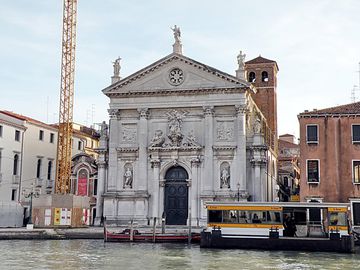

San Stae is the Venetian name for St. Eustace, the 2nd century Christian soldier and martyr. Before his conversion to Christianity, he was named Placidus and served as a general with emperor Trajan. While out hunting one day near Rome, he had a vision of a crucifix rising between a stag's antlers. He was mesmerized and immediately became an ardent Christian. However, his faith soon underwent a series of trials: his servants died of a plague; during a sea-voyage the ship's captain kidnapped his wife; and his sons were then taken away by a wolf. Yet, he did not lose his faith. As a reward, he was soon reunited with his family. But his jubilation did not last long. When he refused to make a sacrifice in honor of the Emperor Hadrian, the emperor ordered him, along with his entire family, to be roasted in a bronze statue of a bull. St. Eustace is venerated in the Roman Catholic, in the Anglican and in the Eastern Orthodox Churches.
The original Church of San Stae was built in the 11th century and then reconstructed in the 17th. The opulent and ornate façade was erected in 1709 by Domenico Rossi. The facade did not, however, win over all the art critics, many of whom considered its decorations, especially the fragmented tympanum above the front door, to be excessively ostentatious.
Inside, the single-nave interior is just as grand as the façade. Three open chapels flank the nave on both sides. The white Istrian marble walls and high ceiling provide a sense of ethereal exultation. In fact, nowhere within the church's walls is it possible to associate Christianity with rigor or suffering. About midway down the nave, on the marble floor lies a tombstone indicating the burial place of Doge Alvise II Mocenigo, who wisely maintained Venice's neutrality during the War of the Spanish Succession that raged throughout Europe during the first 14 years of the 18th century.
Throughout the magnificent Baroque décor we find three masterpieces by three of the most prominent exemplars of 18th century Venetian painting. On the left wall of the presbytery is the Martyrdom of St. Bartholomew by Giambattista Tiepolo, who shows the saint reaching for God as he is being skinned alive. Next to it is the Liberation of St. Peter by Sebastiano Ricci, in which an angel comes and frees the Apostle from prison. On the right side of the presbytery is St James led to his martyrdom by Giambattista Piazzetta, in which the Apostle is not entirely resigned to his fate and still seems to be struggling. In the sacristy we can also find an impressive canvas by Giambattista Pittoni dedicated to St. Eustace himself, who in the painting is being forced to pray to pagan idols by emperor Trajan.
The Church of San Stae is a well-preserved piece of 18th century Venice that is as alive today as it was two hundred years ago.